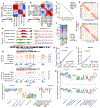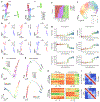GAGE-seq concurrently profiles multiscale 3D genome organization and gene expression in single cells
- PMID: 38744973
- PMCID: PMC11323187
- DOI: 10.1038/s41588-024-01745-3
GAGE-seq concurrently profiles multiscale 3D genome organization and gene expression in single cells
Abstract
The organization of mammalian genomes features a complex, multiscale three-dimensional (3D) architecture, whose functional significance remains elusive because of limited single-cell technologies that can concurrently profile genome organization and transcriptional activities. Here, we introduce genome architecture and gene expression by sequencing (GAGE-seq), a scalable, robust single-cell co-assay measuring 3D genome structure and transcriptome simultaneously within the same cell. Applied to mouse brain cortex and human bone marrow CD34+ cells, GAGE-seq characterized the intricate relationships between 3D genome and gene expression, showing that multiscale 3D genome features inform cell-type-specific gene expression and link regulatory elements to target genes. Integration with spatial transcriptomic data revealed in situ 3D genome variations in mouse cortex. Observations in human hematopoiesis unveiled discordant changes between 3D genome organization and gene expression, underscoring a complex, temporal interplay at the single-cell level. GAGE-seq provides a powerful, cost-effective approach for exploring genome structure and gene expression relationships at the single-cell level across diverse biological contexts.
© 2024. The Author(s), under exclusive licence to Springer Nature America, Inc.
Conflict of interest statement
Competing interests
Z.D. is listed as the inventor on a provisional patent application that covered the GAGE-seq experimental protocol filed by the University of Washington. No competing interests are declared by the other authors.
Figures






Update of
-
Concurrent profiling of multiscale 3D genome organization and gene expression in single mammalian cells.bioRxiv [Preprint]. 2023 Jul 25:2023.07.20.549578. doi: 10.1101/2023.07.20.549578. bioRxiv. 2023. Update in: Nat Genet. 2024 Aug;56(8):1701-1711. doi: 10.1038/s41588-024-01745-3. PMID: 37546900 Free PMC article. Updated. Preprint.
References
-
- Cremer T, Cremer C. Chromosome territories, nuclear architecture and gene regulation in mammalian cells. Nat Rev Genet 2001;2:292–301. - PubMed
Methods-only References
-
- Goloborodko A, Abdennur N, Venev S, hbbrandao, gfudenberg. mirnylab/pairtools: v0.2.0. 2018.
-
- Zhou T GAGE-seq analysis workflow. 2024. 10.5281/zenodo.10888453 - DOI
MeSH terms
Grants and funding
LinkOut - more resources
Full Text Sources
Molecular Biology Databases
Research Materials

